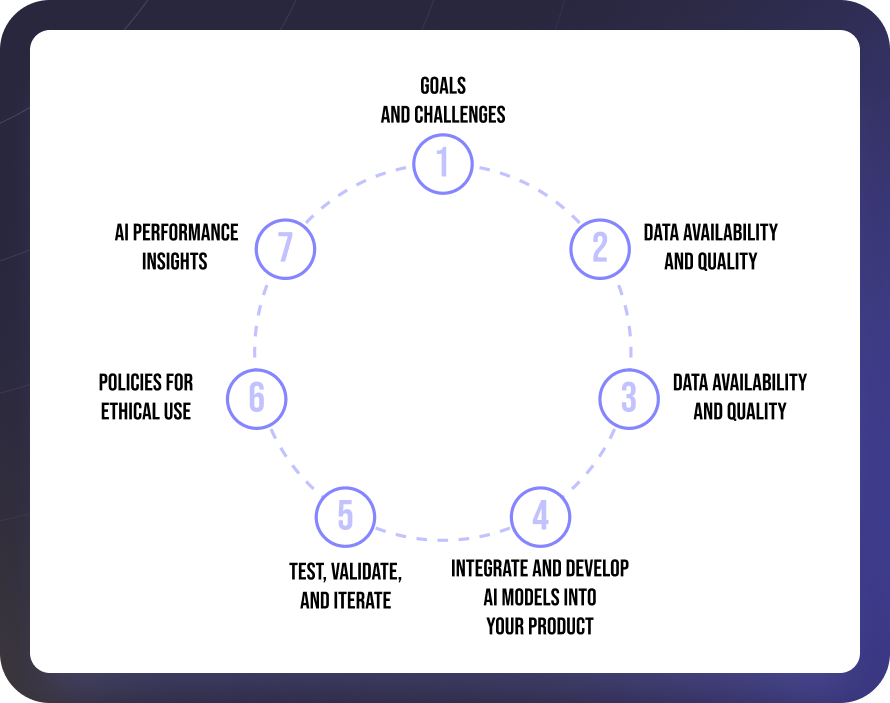What if you were a visionary leader of an IT startup or a growing company figuring out how to take your next big idea to market? You know the market is competitive, the speed is strict, and the stakes are high. Yet, uncertainties about AI integration into your product are holding you back. It could be that AI-powered app development is too complicated, you are scared to waste resources in the wrong direction, or there are too many decisions to make in the tech market.
The pin of modern innovation is AI product development. It’s no longer futuristic — it’s become a fundamental driver of competitive advantage across industries. AI plays a big role in how products are conceived, designed, and delivered, ranging from hyper-personalized user experiences with generative AI to real-time analytics with edge computing. According to Precedence Research, AI software market revenue is estimated to grow to 237.86 billion USD.
Here’s the catch: the potential of AI development is enormous, but the challenges are significant too. To navigate these waters, you need to know AI well enough to take advantage of its capabilities but have a clear plan for aligning technology with business objectives. This is where we step in, not only as developers but as partners, assisting you in transforming complexity into opportunity.
AI in product development: what does it mean?
Product development with AI involves using the newest technologies: machine learning, generative AI, and predictive analytics to design, refine, and perfect a product throughout its lifespan. Incorporating AI into product development enables companies to utilize its power to enhance processes, make better decisions, and improve the quality of the final product.
The use of AI goes beyond automation in product development. It offers the foundation for innovation by allowing teams to analyze massive datasets to predict trends and customize the user experience in new ways that were previously unthinkable. Companies can use AI in product development to analyze product feedback, user behavior, and market dynamics to understand what to create and when to build it using a data-driven approach.
In addition, another role of AI in product features is optimizing at different steps of the product development cycle. Product data analysis via these systems can give actionable insights into improving efficiency and innovation through recommendations.
How does AI transform product development?
Integrating AI in product development radically changes the product conception, creation, and release into the market. Utilizing AI, companies can manage every stage of their product development lifecycle, from ideation with research and development to after-launch optimization.
Enhanced decision-making
Improving decision-making is one of AI’s most significant ways to change product development. Machine learning algorithms can analyze large volumes of data, looking for patterns that may slip under the radar of your product team. This allows product managers to see feature updates and improvements and make informed decisions about them, keeping a product relevant in the competitive market.
Market anticipation and predictive analytics
Furthermore, Machine Learning tools also help companies solve the issue of predictive analytics and foresee customer needs and market trends. For instance, achieving such predictions about a new product’s performance and impact on user satisfaction or even features can be done with the help of AI. It can analyze historical data and customer feedback., reduce risks, and optimize the development cycle by providing accurate forecasts of outcomes.
Streamlined product design
Generative AI development in product design enables the rapid creation of multiple prototype iterations. These AI-generated design ideas can be tested and iterated on, thus saving time and money during the early phases of design. Moreover, AI helps improve the precision of tuning product features through simulations of real-world scenarios and stress tests before the product launch.
Optimization in the product lifecycle
AI isn’t limited to design and production. As new data is collected, AI tools can predict maintenance needs, user behavior changes, and potential improvements throughout product lifecycle management. The continuous feedback loop beyond product quality increases user engagement over time.
Efficiency for the development teams
The third application of AI for development teams is automating repetitive tasks, like testing and data processing, which allows them to focus on higher priorities. It enables the team to stay focused on innovation in its development strategy, delivering better results and faster time to market. AI in product development increases creativity, productivity, and adaptability, leading businesses to offer innovative solutions that are distinct from those fighting in a competitive environment.

More from our blog
Financial business intelligence: The key to unlocking profitability
Financial business intelligence can improve decision-making, organizational efficiency and drive overall growth.
Read moreReal use cases of AI in product development
Many industries have already seen the effects of AI, such as helping businesses revolutionize their product development process. Below are examples of how AI has been successfully used in product development at multiple stages of the product development lifecycle.
1. E-commerce
Major e-commerce platforms, including Amazon and Netflix, have provided their customers with AI tools for better product offerings. AI analyzes customer behavior, preferences, and past purchase algorithms to provide highly personalized products to individual users. It also enhances customer experience and bumps up the chances of conversion and sale, which in turn helps increase businesses’ revenue. By the way, 49% of decision-makers have allocated 5-20% of their company’s technology budget to AI, according to the Hostinger Tutorials survey.
Consider, for instance, an online retailer that can leverage AI to detect buying pastures, predict customer likes, and display the most precise product recommendations.
Xperra incorporated AI and human intelligence (HI) to capture, enrich, clean, and transform the key data points to make them more actionable for mid-market businesses. With the help of Microsoft Power BI and Zoho Analytics, they help them optimize their marketing strategies or operations on the fly.
At the same time, DirectMail2.0 combines direct mail with AI, using trackable methods to enhance response rates. It allows businesses to assign campaign results precisely and acquire new print business.
2. Healthcare
AI in healthcare product development has helped create medical devices with better diagnostics, personalized treatments, and improved patient care. For instance, AI is used to develop wearable health devices that monitor a person’s vital signs in real-time and predict potential health risks before they happen. The use case for “healthcare” refers to an early adopter, IBM Watson Health, which is being merged into diagnostic tools to aid doctors in making wise decisions about treatment plans. Let’s take a look at two real-life examples.
Anatomy Financial eliminates financial processing in health care, the problems of delayed insurance reimbursement, paper documentation of claims, and manual data entry. The banking, accounting data, and claim information assist healthcare providers in closing their financial records with confidence since they have three combined functions on the platform. It also helps organizations avoid constant struggles with operational issues, which take a lot of their time, hence providing quality patient care.
Oracle’s AI-based Electronic Health Record (EHR) solution changes the ‘face’ of this sector by providing EHRs that can be voice-controlled. Patients can access all their records, including histories, tests, and previous notes, from their physicians, making work easier and improving health care delivery. Through AI and cloud solutions, Oracle responds to the longstanding problem in healthcare, becoming an innovative player in EHR.
3. Finance
AI has grown in the financial industry as it is used extensively to provide better product offerings, risk management, fraud detection, etc. In real-time, financial institutions use AI algorithms that analyze transactional data and flag suspicious patterns that may be fraudulent.
Machine learning product development helps American Express to analyze spending behavior patterns and detect unusual transactions that could be fraudulent. AmEx took that one step by uncovering $2 billion worth of possible fraud incidents annually, an enormously important step in the fight against fraud. As described above, a proactive approach requires that financial products be secure and increase customer trust.
Besides ML, graph database technology is changing the face of financial fraud detection as it helps them map the relation of accounts, transactions, and entities. Unlike traditional data models such as relational databases, graph databases analyze the data through networking systems, making it easier to detect fraud crises.
An optimal path like PageRank and community detection first evaluates account distance, centrality, and cluster to detect fraud. This approach enhances detection accuracy while minimizing false positives and investigation time that cost banks millions of dirhams annually and rebuilding customer confidence.
Additionally, AI applications help develop your new product based on AI-based insights to meet the latest market demands, such as personalized investment plans.
4. Education
AI-enabled EdTech offers individually tailored learning paths to learn complex concepts at the student’s pace. For instance, adaptive learning platforms use AI to study a pupil’s performance and propose personalized schemes. This increases retention and comprehension.
Take a hypothetical situation where virtual tutors supplied by AI-powered tools deliver near real-time feedback and fill knowledge holes in education. For example, My Tutor uses AI to pair students with the best-fit tutor for their unique learning styles and goals.
As you can see, there are vast AI benefits in product development. AI is strong in automating admin tasks, e.g., grading assignments, lesson scheduling, and freeing teachers to teach. Our team embraces generative AI models to develop customized content for individuals, such as quizzes and interactive exercises, further enriching the learning experience.
There are so many examples in EdTech to choose from. Still, one outstanding example is Finance Unlocked. This platform offers on-demand, video-based financial education using AI, specifically brought in to deliver content most effectively. These innovations actively make education relevant to a driven world by democratizing access to quality education.
5. Entertainment
The entertainment industry uses AI to present engaging content while optimizing production processes. AI-powered tools are also aiding content creators in tasks such as AI-powered script writing, AI editing, and even AI-generated music.
For example, Uberduck is a voiceover tool for intelligent speech generation based on the most recent advancements in ML. With a range of deep learning models and an extensive archive of voices, Uberduck offers many business-specific voices for content marketing. This innovative technology has become valuable in various business branches, like entertainment, advertisement, and customer relations.
Our approach to developing Uberduck aimed to give users maximum flexibility and ease of use. We applied a system modularization approach to address the various requirements of specific industries. The Agile development process allowed for world feedback and subsequent dynamic improvement of audio performance.
Getting started with AI and product development

Undoubtedly, integrating AI into your product development process sounds like a daunting challenge, but it also presents an incredible opportunity for your organization. With the right approach, AI technologies will not disrupt your product development process; instead, they will easily blend with it to increase efficiency and always strive to satisfy your customers.
But where do you begin? How do you make sure that your AI efforts don’t become just technically feasible but also ready to attack the kinds of business problems you need solving? If you want to improve user experience, optimize product features, or keep ahead of the curve, Geniusee can help you get started on the successful path of AI product development.
1. Goals and challenges
The first step towards integrating AI into the product development process is identifying the challenges and your business goals. Are you seeking to boost the product features, enhance the user experience, query user demand, or streamline operational efficiency? You’ll know which technologies will be relevant to your product by identifying your objectives.
For instance, improving diagnostic accuracy or reducing operational costs makes sense if you create a new AI-powered product for the healthcare industry. For e-commerce businesses, you can use AI tools to make personalized product recommendations and increase customer engagement.
2. Data availability and quality
Much data is needed for models to learn and make accurate predictions. Before adding AI to your product development, assess the quality and availability of the data you feed it. Providing high-quality data for training AI algorithms is very important, and this will, of course, directly affect how well the product will perform and how accurate they are.
The most important thing you’ll have to ensure is that you organize your data, make it relevant to your product, and have an error-proof writing process. Sometimes, businesses need to allocate time and money to data cleaning or augmentation processes before taking advantage of AI models.
3. AI tools & algorithms
Understanding the right AI tools and algorithms to choose from is critical for success in this stage of product development. Depending on your product concepts, you must deploy many AI and machine learning models, including supervised learning for classification or deep image and speech recognition knowledge. Generative AI can help create new designs or automate content generation.
Consult AI specialists or work with a team of programmers skilled in AI integration to choose the most suitable algorithm or AI system for your goals and development product lifecycle.
4. Integrate and develop AI models into your product
After picking your tools, the next step is to build and integrate AI models into your product. This phase is about training the AI models using your data and testing the models so they perform and deploy. Working closely with your product development team is essential — it should be easy to integrate and align your AI systems to your product features.
Whether for next-best-action predictions, individualized user experience, or throughput, your AI models must augment your product’s key value proposition. Their integration into your entertainment should not be disruptive and show an ROI to your end users.


Thank you for Subscription!
5. Test, validate, and iterate
Testing and validation ensure that your AI-enabled product serves its intended purpose, meets users’ expectations, and complies with the highest standards.
You must conduct many tests to see how well-developed AI algorithms will work under real-life conditions. This phase will also reveal any data quality problems with the selected data set, the performance of the resultant model, and the adopted system.
Refine your models according to how they performed during and after a test or in response to received feedback. They enable you to adjust your models incrementally, fine-tune a product’s attributes, and increase customer satisfaction.
6. Policies for ethical use
Of course, integrating AI into your product development requires attention to ethical issues and compliance. Mind that your AI models do no harm and are impartial to maintain your product’s integrity. Also, you can establish laws like GDPR or CCPA to protect user information and gain users’ trust.
Organizations embracing ethical AI will gain a competitive edge as buyers and governing bodies demand higher moral standards.
7. AI performance insights
Once your product integrated with AI is launched, it is critical to constantly analyze its performance and ensure it meets customer market objectives. There is always an error when judging product usage and opportunities for enhancement. Through AI-aided analytical tools, the evaluation of customer feedback is more accurate.
AI in product development is a never-ending process that needs frequent enhancement. More data collected will mean that your AI systems can progress and positively impact product performance.
Legal and ethical considerations in the AI for product development
While great opportunities are opening up, some complex legal and ethical problems will arise as AI becomes intrinsic to product development. Ensuring regulatory compliance and observing ethical standards will be key to avoiding risks and fostering user trust. Protection of user data, ensuring fairness in AI algorithms, and following specific industry regulations are critical considerations when integrating AI into the products developed by any organization.
Primary legal and ethical considerations for using AI in product development include:
Consideration | Why it matters |
Data privacy | Protecting user privacy and staying within the bounds of legal requirements builds trust among the customer and avoids penalties. |
Bias and fairness | Fair AI treats all users relatively and does not put organizations at risk legally and reputationally. |
Transparency and explainability | More transparency means building, especially when AI decisions involve users’ lives or businesses. |
Intellectual property | Protect your organization’s innovations and respect others’ intellectual property rights. |
Accountability and liability | Clear accountability frameworks protect your organization from liability, protecting consumer confidence. |
Security | Data security protects critical information and ensures the system’s integrity by preventing breaches and their respective fines. |
Ethical AI | Ethical AI instills trust among users and regulators and fosters responsible innovation. |
Industry regulations compliance | Industry regulations will ensure that AI applications meet sector-specific standards to protect public interests. |
Conclusion
Ultimately, we conclude that using AI in your product development might not only be a trend, as many product development strategies can substantively improve your product’s potential, speed, and market pertinency. Using AI gives you a sharper ability to make more informed decisions, predict market trends, personalize user experiences, and run operations throughout the product lifecycle.
However, integrating AI is successful only when you choose the right tools, manage your data appropriately, and constantly improve your AI models to fit your business objectives. With AI, you’re not adding more product features; you’re laying the foundation for innovation and growth over the long term.
As an enterprise AI development company, Geniusee specializes in helping organizations craft an AI-powered product at all stages. We’re here to ensure your product development process is super efficient and mutually beneficial to help you create brilliant products that propel your business ahead of time.
Get started on your journey to product innovation powered by AI today, and contact us to discuss your unique case.





















